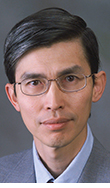Study eyes influence of STEM activities on children for underrepresented groups

Francis Quek
Elementary school children performed fun tasks on two Saturdays in December designed to stoke their interest in science, technology, engineering and math and perhaps place them on a technology-oriented career path as part of a National Science Foundation-funded [study] (http://nsf.gov/awardsearch/showAward?AWD_ID=1433770&HistoricalAwards=false) led by [Francis Quek] (http://one.arch.tamu.edu/news/2013/12/6/viz-hires-scholar/) , professor of [visualization] (http://viz.arch.tamu.edu) at Texas A&M.
The three-year, $1 million project is emphasizing participation of Latino and African-American children, ethnic groups traditionally underrepresented in STEM fields, said Quek.
In sessions December 7 and 14, 2014, students in grades 3-5 engaged in arts, crafts and storytelling activities with STEM components, such as electricity, circuitry, 3-D printing, LED lights, transistors, and age-appropriate geometry.
For instance, in one activity, children constructed a simple circuit that connects a small light-emitting diode to a battery, forming the “eyes” of animal characters used to stage a story.
The study addresses what the U.S. Department of Commerce is calling a projected mismatch between the amount of future jobs requiring STEM skills and the supply of qualified workers to fill them.
“Math skills and other STEM competencies are important to the country's long-term competitiveness because today's young children are tomorrow's workforce,” said J.D. Chesloff, chair of the Massachusetts Board of Early Education and Care, in a March 2013 Education Week [article] (http://www.edweek.org/ew/articles/2013/03/06/23chesloff.h32.html) . “Workers who are fluent in these competencies will be more prepared and qualified to fill the jobs that our innovation economy demands.”
Quek, the project’s principal investigator, will be working with fellow Texas A&M faculty researchers in the departments of [teaching, learning and culture] (http://tlac.tamu.edu) and [psychology] (http://psychology.tamu.edu/html/home.html) to quantify the extent to which children in the study see themselves as participants and contributors to STEM fields and interested in STEM careers.
“The study exercises may lead participants to strong affiliations with the larger STEM community, create a sense of belonging in that community, and help prepare children to easily assimilate within the rapidly changing technological world,” said Quek.
Study activities, he said, will reflect the spirit of the [maker movement] (http://www.techopedia.com/definition/28408/maker-movement) , a recent phenomenon that joins individuals involved in engineering-oriented pursuits in a social environment that features prototyping, invention and creativity.
Quek and his fellow researchers are looking to instill a “maker's” mindset in children and benefit society through contributions to the future STEM workforce.
Tags
- archone gallery
- coa gallery
- diversity
- feature
- interdisciplinary
- outreach
- research
- research gallery
- rss
- technology
- visualization
- viz gallery
Related Posts

Viz prof-led institute to study best tech learning methods

Viz prof to learn if storytelling aids science learning

Initiative fusing arts, technology education gains momentum

Teacher 'making’ workshop fosters STEM education

Oct. 23 symposium spotlighted college, faculty research
Follow Us
Facebook Twitter Vimeo Youtube Flickr RSS
Recent Posts

Planning prof heads study of disaster housing aid

A message from the dean

Former student remembered as expert planner

Leading educator named new head of Architecture Dept.









_thumbnail_small.png)
